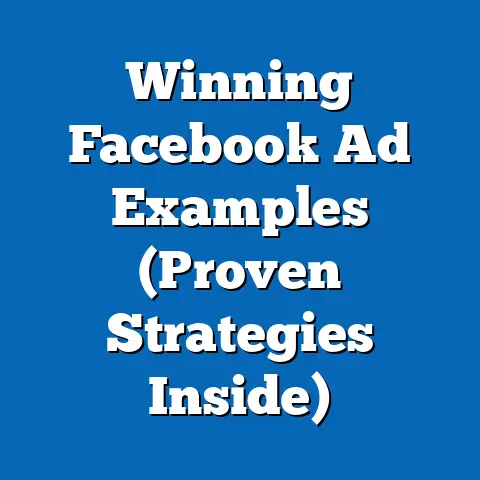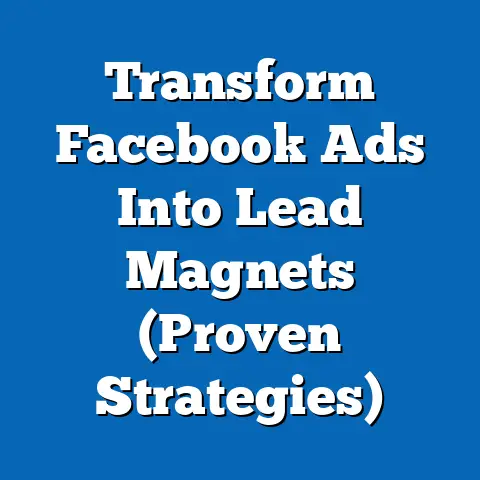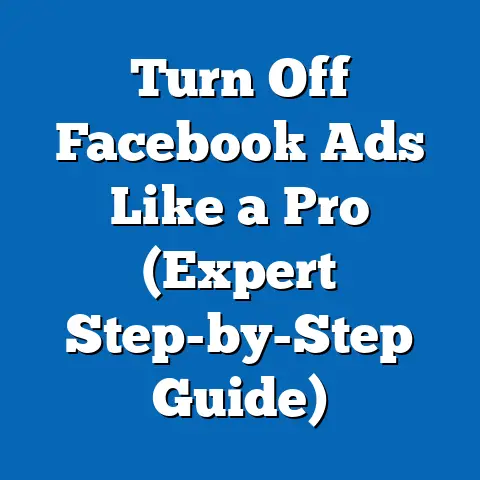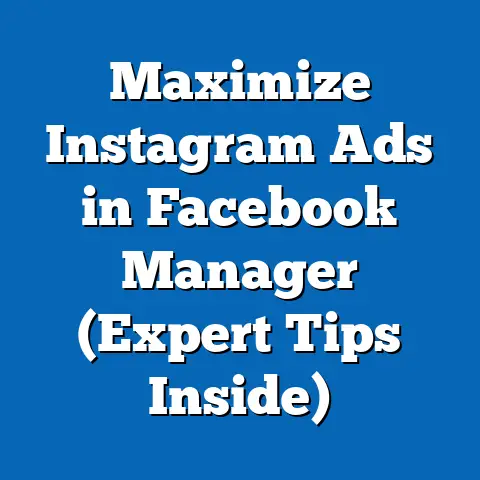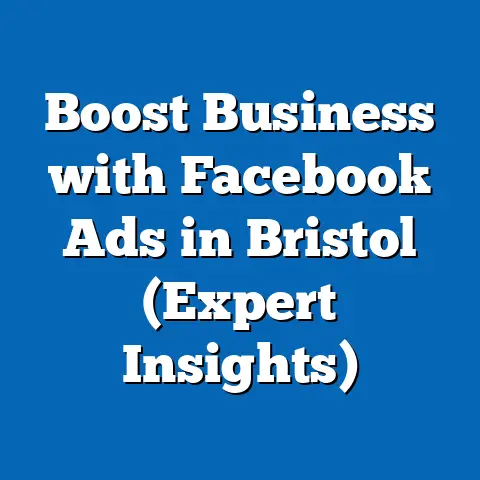Maximize Impact: Tailoring Facebook Ads for Each Product (Pro Tips)
Imagine launching a new product, pouring your heart and soul into its creation, only to see your Facebook ad campaigns fall flat. I’ve been there, and it’s a frustrating experience. Generic ads, the kind that try to appeal to everyone, often end up appealing to no one. The truth is, in today’s hyper-competitive digital landscape, personalization is no longer a luxury; it’s a necessity. The key to skyrocketing your ROI on Facebook ads lies in tailoring each campaign specifically to the unique characteristics and audience of each product.
Think of it like this: you wouldn’t wear the same outfit to a black-tie gala as you would to a casual backyard barbecue. Similarly, your Facebook ads need to be dressed appropriately for the “party” they’re attending.
I remember working with a client who sold both high-end luxury watches and affordable fitness trackers. Initially, they ran similar ads for both product lines, focusing on broad demographic targeting. The results were underwhelming. It wasn’t until we completely overhauled their strategy, crafting distinct campaigns tailored to each product’s unique appeal, that we saw a dramatic increase in sales.
The luxury watches needed ads that evoked exclusivity, craftsmanship, and status, targeting affluent individuals with interests in luxury goods and fine dining. The fitness trackers, on the other hand, needed ads that focused on health, performance, and affordability, targeting fitness enthusiasts with interests in running, cycling, and healthy eating. The shift was remarkable, proving that one size definitely does not fit all in the world of Facebook advertising.
In this guide, I’m going to share the pro tips I’ve learned over years of managing Facebook ad campaigns for a diverse range of products. We’ll dive deep into understanding your product, segmenting your audience, crafting compelling ad copy, designing eye-catching visuals, and A/B testing for continuous optimization. Get ready to transform your Facebook ad campaigns and unlock the true potential of your products!
Section 1: Understanding Your Product
Before you even think about creating a Facebook ad, you need to have a deep, almost intimate, understanding of the product you’re advertising. This isn’t just about knowing the features; it’s about understanding the benefits, the target demographics, and what makes your product truly unique.
Think of your product as a person. What are its defining characteristics? What are its strengths and weaknesses? What problems does it solve? What are its aspirations? The more you know, the better you can communicate its value to potential customers.
Here’s a breakdown of the key elements to consider:
- Product Features: These are the specific attributes of your product. For example, a smartphone might have a 6.7-inch display, a 12MP camera, and 128GB of storage.
- Product Benefits: These are the advantages that customers derive from using your product. The smartphone’s features might translate into benefits like a better viewing experience, high-quality photos, and ample storage for apps and files.
- Target Demographics: This refers to the specific groups of people who are most likely to purchase your product. Consider factors like age, gender, location, income, education, and occupation.
- Unique Selling Propositions (USPs): This is what sets your product apart from the competition. What makes it better, faster, cheaper, or more innovative?
To truly understand your product, I recommend creating buyer personas. A buyer persona is a semi-fictional representation of your ideal customer, based on research and data about your existing and potential customers. Give your persona a name, a background, a motivation, and a goal. This will help you humanize your target audience and tailor your ads to their specific needs and desires.
For example, let’s say you’re selling a line of organic skincare products. Your buyer persona might be “Eco-Conscious Emily,” a 35-year-old woman who is passionate about sustainability and healthy living. She values natural ingredients, ethical sourcing, and cruelty-free products. Knowing this, you can craft ads that highlight the organic nature of your skincare line, its commitment to sustainability, and its ethical production practices.
The advertising needs can differ significantly depending on the product category. Let’s consider a few examples:
- Luxury Goods: Ads for luxury goods should focus on exclusivity, craftsmanship, and status. They should evoke a sense of aspiration and desire, targeting affluent individuals who appreciate quality and luxury.
- Everyday Essentials: Ads for everyday essentials should focus on practicality, convenience, and affordability. They should highlight how the product solves a common problem and makes life easier.
- Tech Gadgets: Ads for tech gadgets should focus on innovation, performance, and functionality. They should appeal to tech-savvy individuals who are looking for the latest and greatest technology.
Takeaway: Before you create a single Facebook ad, take the time to truly understand your product and your target audience. Create buyer personas, identify your USPs, and consider the unique advertising needs of your product category. This foundational knowledge will be invaluable as you move forward in crafting effective Facebook ad campaigns.
Section 2: Audience Segmentation
Once you have a solid understanding of your product, the next step is to segment your audience. Audience segmentation is the process of dividing your target audience into smaller, more specific groups based on shared characteristics. This allows you to create more relevant and targeted ads, which can lead to higher engagement rates and lower advertising costs.
Think of it like fishing. You wouldn’t use the same bait to catch a trout as you would to catch a marlin. Similarly, you need to use different messaging and targeting strategies to reach different segments of your audience.
Facebook offers a wealth of targeting options, allowing you to segment your audience based on a variety of factors, including:
- Demographics: This includes factors like age, gender, location, education, and occupation.
- Interests: This includes the things that people are interested in, such as hobbies, sports, movies, music, and books.
- Behaviors: This includes the actions that people take on Facebook and other websites, such as purchasing products, visiting websites, and engaging with content.
- Psychographics: This includes people’s values, attitudes, and lifestyles.
One of the most powerful tools for audience segmentation is Facebook’s Audience Insights tool. This tool allows you to gather data about your existing and potential customers, providing valuable insights into their demographics, interests, behaviors, and psychographics.
I remember using Audience Insights to help a client who sold handmade jewelry. Initially, they were targeting a broad audience of women aged 25-55. However, by using Audience Insights, we discovered that their most engaged customers were actually women aged 30-45 who were interested in bohemian fashion, sustainable living, and handmade crafts. By narrowing their targeting to this more specific segment, we saw a significant increase in their ad engagement and sales.
Here are some tips for using Facebook’s Audience Insights tool:
- Start with your existing customer data: Upload your customer list to Facebook and use Audience Insights to learn more about their demographics, interests, and behaviors.
- Explore different interest categories: Experiment with different interest categories to see which ones resonate with your target audience.
- Look for overlapping interests: Identify interests that are commonly shared by your target audience.
- Use the “Page Likes” feature: See which Facebook pages your target audience likes. This can provide valuable insights into their interests and values.
A tailored audience can lead to more relevant ad placements and higher engagement rates. When your ads are relevant to the people who are seeing them, they are more likely to click, engage, and convert. This can lead to a lower cost per click (CPC) and a higher return on ad spend (ROAS).
Takeaway: Audience segmentation is crucial for effective Facebook advertising. Use Facebook’s Audience Insights tool to gather data about your target audience and create more relevant and targeted ads. A tailored audience can lead to higher engagement rates, lower advertising costs, and a better return on ad spend.
Section 3: Crafting Compelling Ad Copy
Now that you understand your product and your target audience, it’s time to craft compelling ad copy that resonates with them. Ad copy is the text that appears in your Facebook ad, and it’s your opportunity to persuade potential customers to take action.
Think of your ad copy as a mini-sales pitch. You need to capture the attention of your target audience, highlight the benefits of your product, and entice them to click on your ad.
Here are the key elements of effective ad copy:
- Headline: This is the first thing that people will see, so it needs to be attention-grabbing and relevant to your target audience.
- Body Text: This is where you can provide more information about your product and its benefits. Keep it concise, clear, and persuasive.
- Call-to-Action (CTA): This is the action that you want people to take after seeing your ad. Use a clear and compelling CTA, such as “Shop Now,” “Learn More,” or “Sign Up.”
- Emotional Triggers: Tap into emotions that resonate with your audience, such as excitement, fear, or a desire for belonging.
The tone and messaging of your ad copy should align with the product and the audience. For example, if you’re selling luxury goods, your ad copy should be sophisticated and refined. If you’re selling everyday essentials, your ad copy should be practical and straightforward.
I once worked with a client who sold adventure travel tours. Their initial ad copy was generic and uninspired, focusing on the logistics of the tours rather than the experience. It wasn’t until we revamped their ad copy to focus on the emotional aspects of adventure travel, such as excitement, discovery, and personal growth, that we saw a significant increase in bookings.
Here are some examples of successful ad copies for different products:
- Luxury Goods (High-End Watch): “Experience the epitome of craftsmanship. Our handcrafted watches are a testament to timeless elegance and unparalleled precision. Shop now and elevate your style.”
- Everyday Essentials (Reusable Water Bottle): “Stay hydrated and help the planet with our reusable water bottle. Durable, eco-friendly, and easy to clean. Order yours today and make a difference.”
- Tech Gadgets (Wireless Headphones): “Immerse yourself in sound with our wireless headphones. Crystal-clear audio, comfortable fit, and long-lasting battery life. Get yours now and experience the freedom of wireless.”
Takeaway: Crafting compelling ad copy is essential for effective Facebook advertising. Use attention-grabbing headlines, concise body text, clear CTAs, and emotional triggers to resonate with your target audience. Align the tone and messaging with the product and the audience to maximize your impact.
Section 4: Designing Eye-Catching Visuals
Visuals play a crucial role in Facebook ads. In fact, many studies show that visuals are the first thing people notice when scrolling through their newsfeeds. They can either grab a user’s attention or cause them to scroll right past your ad. Therefore, your visuals need to be stunning, relevant, and aligned with your brand.
Think of your visuals as the “face” of your ad. They need to be attractive, engaging, and representative of your product and brand.
Here are some best practices for creating stunning images and videos for your Facebook ads:
- Use high-quality images and videos: Avoid blurry or pixelated visuals.
- Showcase your product in action: Demonstrate how your product works and its benefits.
- Use bright, vibrant colors: Capture attention and make your ad stand out.
- Include people in your visuals: People are more likely to engage with ads that feature other people.
- Keep it simple: Avoid clutter and focus on the key message.
- Optimize for mobile: Most people will be viewing your ads on their smartphones, so make sure your visuals are optimized for mobile viewing.
Brand consistency is also crucial in visual design. Use the same colors, fonts, and imagery across all of your ads to create a cohesive brand identity. This will help people recognize your brand and build trust.
I remember working with a client who sold organic coffee. Initially, their ads featured generic stock photos of coffee beans and cups. It wasn’t until we invested in professional photography that showcased their coffee beans in a natural and authentic setting that we saw a significant increase in engagement. The new visuals conveyed the brand’s commitment to quality and sustainability, which resonated with their target audience.
If you’re not a designer, don’t worry. There are plenty of tools available that can help you create appealing graphics. Canva and Adobe Spark are two popular options that offer a wide range of templates and design elements.
Takeaway: Eye-catching visuals are essential for effective Facebook advertising. Use high-quality images and videos, showcase your product in action, use bright colors, and maintain brand consistency. If you’re not a designer, use tools like Canva or Adobe Spark to create appealing graphics.
Section 5: A/B Testing and Optimization
The final step in creating tailored Facebook ads is A/B testing and optimization. A/B testing is the process of comparing two versions of an ad to see which one performs better. This allows you to continuously improve your ads and maximize your return on ad spend.
Think of A/B testing as a scientific experiment. You’re testing different hypotheses to see which one yields the best results.
Here are some elements that you can test in your Facebook ads:
- Headlines: Test different headlines to see which one grabs the most attention.
- Images: Test different images to see which one resonates with your target audience.
- Audience Segments: Test different audience segments to see which one is most responsive.
- Ad Placements: Test different ad placements to see which one yields the best results.
- Call-to-Actions: Test different CTAs to see which one drives the most conversions.
I always tell my clients that A/B testing is not a one-time thing; it’s an ongoing process. You should be constantly testing and optimizing your ads to ensure that they are performing at their best.
I remember working with a client who sold online courses. Initially, they were only running ads on the Facebook newsfeed. However, by A/B testing different ad placements, we discovered that their ads performed much better on Instagram. By shifting their budget to Instagram, we saw a significant increase in their ad engagement and conversions.
To analyze your results, pay attention to key metrics like:
- Click-Through Rate (CTR): Measures the percentage of people who see your ad and click on it.
- Conversion Rate: Measures the percentage of people who click on your ad and complete a desired action, such as making a purchase or signing up for a newsletter.
- Cost Per Click (CPC): Measures the average cost of each click on your ad.
- Return on Ad Spend (ROAS): Measures the revenue generated for every dollar spent on advertising.
Takeaway: A/B testing and optimization are essential for continuous improvement in Facebook advertising. Test different elements of your ads, analyze the results, and make data-driven decisions to optimize your ad performance.
Conclusion
Tailoring your Facebook ads to each product is not just a best practice; it’s a necessity for maximizing your impact and achieving a high return on ad spend. By understanding your product, segmenting your audience, crafting compelling ad copy, designing eye-catching visuals, and A/B testing for continuous optimization, you can create Facebook ad campaigns that truly resonate with your target audience and drive results.
I’ve seen firsthand the transformative power of tailored Facebook ads. It’s not about throwing money at the platform; it’s about understanding your audience and crafting a message that speaks directly to their needs and desires.
So, take the pro tips I’ve shared in this guide and implement them in your Facebook ad campaigns. Don’t be afraid to experiment, test, and optimize. The more you invest in understanding your product and your audience, the more successful your Facebook ad campaigns will be. Now go out there and create some amazing ads!

